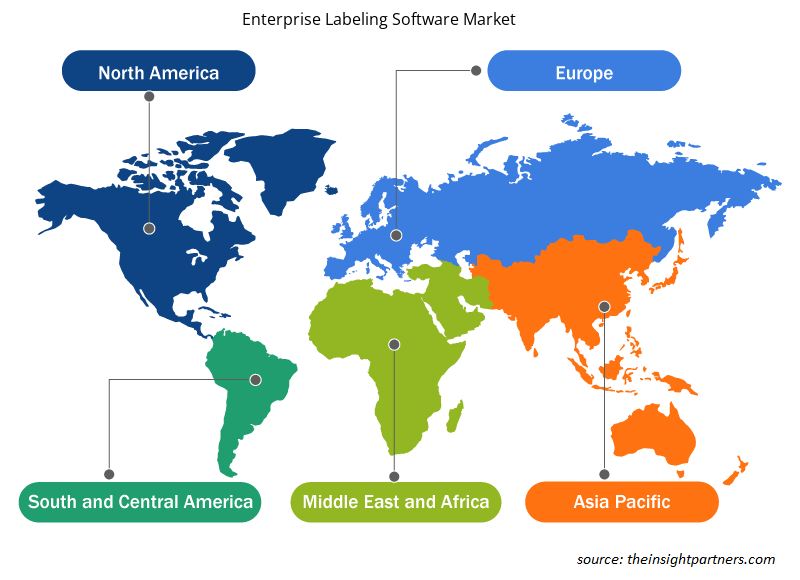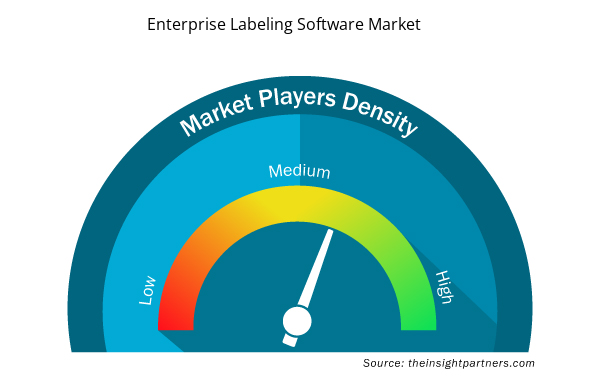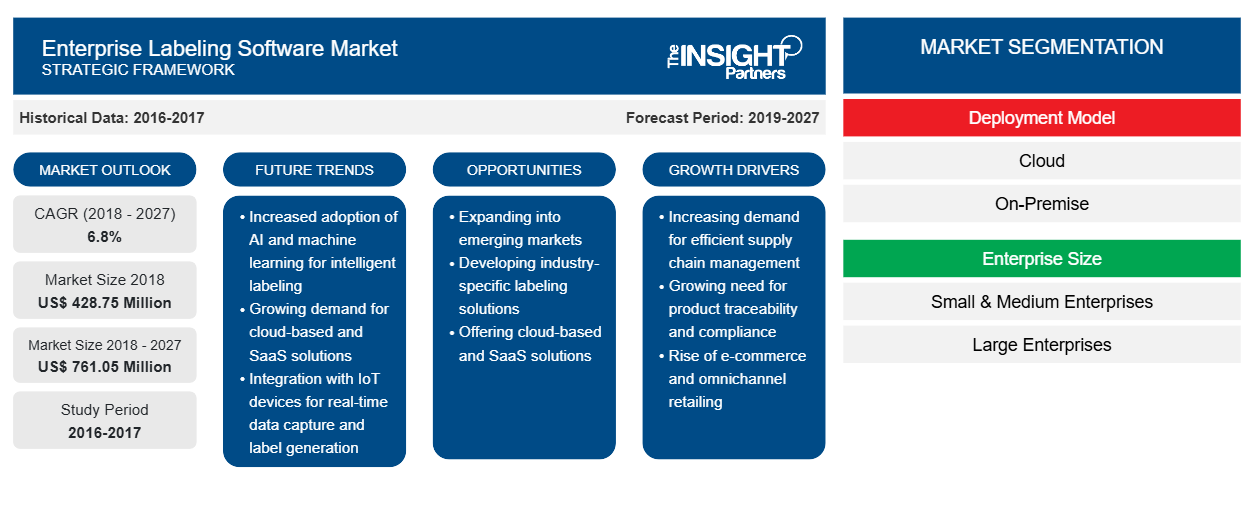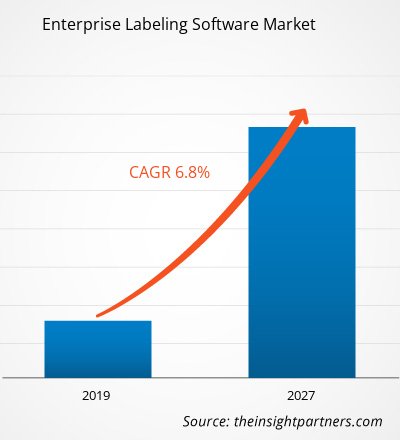Le marché des logiciels d'étiquetage d'entreprise était évalué à 428,75 millions de dollars américains en 2018 et devrait atteindre 761,05 millions de dollars américains d'ici 2027 avec un taux de croissance annuel composé de 6,8 % au cours de la période de prévision.
L'expansion de diverses industries d'utilisation finale à travers le monde, en particulier dans les régions APAC et MEA, ainsi que l'évolution de la gestion et de la planification des données au cours des dernières années, ont introduit l'étiquetage comme une opération essentielle pour de nombreuses petites et moyennes entreprises. Il existe un besoin croissant d'étiquetage d'entreprise dans diverses industries d'utilisation finale pour rationaliser de multiples opérations commerciales. Le logiciel d'étiquetage d'entreprise permet de maintenir la précision pendant le processus d'impression et garantit la conformité des entreprises aux réglementations de divulgation des informations sur les produits. En outre, l'intégration de ce logiciel offre divers avantages, notamment la collaboration des données au niveau de l'entreprise, l'efficacité de la chaîne d'approvisionnement et la flexibilité et la cohérence de l'impression des étiquettes. Par conséquent, l'adoption accrue de l'étiquetage d'entreprise devrait stimuler la croissance du marché des logiciels d'étiquetage d'entreprise
Le logiciel d'étiquetage d'entreprise améliore la rapidité, la précision, l'efficacité, les économies de coûts et les délais de livraison, tout en permettant aux entreprises de relever des défis d'étiquetage complexes. L'amélioration de la qualité de l'étiquetage contribue à renforcer l'avantage concurrentiel de l'entreprise sur le marché mondial.
Personnalisez ce rapport en fonction de vos besoins
Vous bénéficierez d'une personnalisation gratuite de n'importe quel rapport, y compris de certaines parties de ce rapport, d'une analyse au niveau des pays, d'un pack de données Excel, ainsi que de superbes offres et réductions pour les start-ups et les universités.
- Obtenez les principales tendances clés du marché de ce rapport.Cet échantillon GRATUIT comprendra une analyse de données, allant des tendances du marché aux estimations et prévisions.
Aperçu régional du marché des logiciels d'étiquetage d'entreprise
Les tendances et facteurs régionaux influençant le marché des logiciels d’étiquetage d’entreprise tout au long de la période de prévision ont été expliqués en détail par les analystes d’Insight Partners. Cette section traite également des segments et de la géographie du marché des logiciels d’étiquetage d’entreprise en Amérique du Nord, en Europe, en Asie-Pacifique, au Moyen-Orient et en Afrique, ainsi qu’en Amérique du Sud et en Amérique centrale.

- Obtenez les données régionales spécifiques au marché des logiciels d'étiquetage d'entreprise
Portée du rapport sur le marché des logiciels d'étiquetage d'entreprise
| Attribut de rapport | Détails |
|---|---|
| Taille du marché en 2018 | 428,75 millions de dollars américains |
| Taille du marché d'ici 2027 | 761,05 millions de dollars américains |
| Taux de croissance annuel composé mondial (2018 - 2027) | 6,8% |
| Données historiques | 2016-2017 |
| Période de prévision | 2019-2027 |
| Segments couverts | Par modèle de déploiement
|
| Régions et pays couverts | Amérique du Nord
|
| Leaders du marché et profils d'entreprises clés |
|
Densité des acteurs du marché des logiciels d'étiquetage d'entreprise : comprendre son impact sur la dynamique des entreprises
Le marché des logiciels d'étiquetage d'entreprise connaît une croissance rapide, tirée par la demande croissante des utilisateurs finaux en raison de facteurs tels que l'évolution des préférences des consommateurs, les avancées technologiques et une plus grande sensibilisation aux avantages du produit. À mesure que la demande augmente, les entreprises élargissent leurs offres, innovent pour répondre aux besoins des consommateurs et capitalisent sur les tendances émergentes, ce qui alimente davantage la croissance du marché.
La densité des acteurs du marché fait référence à la répartition des entreprises ou des sociétés opérant sur un marché ou un secteur particulier. Elle indique le nombre de concurrents (acteurs du marché) présents sur un marché donné par rapport à sa taille ou à sa valeur marchande totale.
Les principales entreprises opérant sur le marché des logiciels d'étiquetage d'entreprise sont :
- Logiciel BLUE, LLC
- Société CYBRA
- Data Systems International, Inc. (DSI)
- Endicia,
- Euro Plus Ltd.
Avis de non-responsabilité : les sociétés répertoriées ci-dessus ne sont pas classées dans un ordre particulier.

- Obtenez un aperçu des principaux acteurs du marché des logiciels d'étiquetage d'entreprise
Les acteurs du marché de la gestion de contenu d'entreprise se concentrent sur des stratégies telles que les fusions, les acquisitions et les initiatives de marché pour maintenir leurs positions sur le marché. Quelques développements des principaux acteurs sont énumérés ci-dessous :
- En novembre 2019, NiceLabel a lancé la version 2 de son package ABAP, qui prend en charge à la fois SAP ECC et SAP S/4HANA. Cela permet aux organisations de numériser entièrement le processus d'assurance qualité de l'étiquetage et de réduire à la fois les erreurs d'étiquetage et les délais d'expédition.
- En avril 2018, Innovatum, Inc. a annoncé la certification ISO 9001:2015 pour son système de gestion de la qualité pour le développement, la livraison et le support de logiciels en tant que fournisseur de logiciels pour les sciences de la vie, par un organisme accrédité ANAB.
Segments du marché mondial des logiciels d'étiquetage d'entreprise :
Marché des logiciels d’étiquetage d’entreprise – Par modèle de déploiement
- Sur site
- Nuage
Marché des logiciels d'étiquetage d'entreprise – Par taille d'entreprise
- Petites et moyennes entreprises
- Grande entreprise
Marché des logiciels d'étiquetage d'entreprise – Par utilisateur final
- Produits de grande consommation
- Vente au détail
- Soins de santé
- Entreposage et logistique
- Autres
Marché des logiciels d'étiquetage d'entreprise – Par géographie
Amérique du Nord
- NOUS
- Canada
- Mexique
Europe
- France
- Allemagne
- Italie
- Espagne
- ROYAUME-UNI
- Reste de l'Europe
Asie-Pacifique (APAC)
- Australie
- Chine
- Inde
- Japon
- Reste de l'APAC
Moyen-Orient et Afrique (MEA)
- Arabie Saoudite
- Émirats arabes unis
- Afrique du Sud
- Reste de la MEA
Amérique du Sud (SAM)
- Brésil
- Reste de SAM
Entreprises
- BLUE Software, LLC (Esko)
- Société CYBRA
- Data Systems International, Inc. (DSI)
- Endicia
- Euro Plus Ltd
- Innovatum, Inc.
- Loftware, Inc.
- PRISYM ID Ltée.
- Seagull Scientific, Inc.
- Teklynx Newco SAS
- Analyse historique (2 ans), année de base, prévision (7 ans) avec TCAC
- Analyse PEST et SWO
- Taille du marché Valeur / Volume - Mondial, Régional, Pays
- Industrie et paysage concurrentiel
- Ensemble de données Excel



Report Coverage
Revenue forecast, Company Analysis, Industry landscape, Growth factors, and Trends

Segment Covered
This text is related
to segments covered.

Regional Scope
North America, Europe, Asia Pacific, Middle East & Africa, South & Central America

Country Scope
This text is related
to country scope.
Questions fréquemment posées
Various end-use industries have used reporting solutions and business intelligence (BI) with many of their enterprise applications to improve business operations. Companies are looking forward to using BI to monitor labels printed across facilities to ensure that the quality of labels printed is in line with the expected output of a facility. Moreover, they are looking forward to using this insight for better maintenance schedules for printers and analyzing trends in the label production to fine-tune labeling environments. Therefore, the use of analytics with enterprise labeling is a major emerging trend for enterprise labeling software market.
The growth of the enterprise labeling software market in Europe is primarily attributed to the strong retail industry in countries such as India, China, and Japan, owing to the strong customer base. Also, the FMCG industry in countries such as India and China plays a vital role in supporting any country’s economy. Since the demand for enterprise labeling software is high across the FMCG sector; therefore, a strong FMCG sector supports the increasing demand for enterprise labeling software in the region.
The growing demand for enterprise labeling software in end-use industries in emerging economies such as MEA and APAC is driving the growth of enterprise labeling software market. Also, the surging demand for flexible enterprise labeling solutions to reduce the inconsistency, and improve efficiency is also a major driving factor for the enterprise labeling software market.
Trends and growth analysis reports related to Technology, Media and Telecommunications : READ MORE..
The List of Companies
- BLUE Software, LLC
- CYBRA Corporation
- Data Systems International, Inc. (DSI)
- Endicia,
- Euro Plus Ltd.
- Innovatum, Inc.
- Loftware, Inc.
- PRISYM ID Ltd.
- Seagull Scientific, Inc.
- Teklynx Newco SAS.
The Insight Partners performs research in 4 major stages: Data Collection & Secondary Research, Primary Research, Data Analysis and Data Triangulation & Final Review.
- Data Collection and Secondary Research:
As a market research and consulting firm operating from a decade, we have published and advised several client across the globe. First step for any study will start with an assessment of currently available data and insights from existing reports. Further, historical and current market information is collected from Investor Presentations, Annual Reports, SEC Filings, etc., and other information related to company’s performance and market positioning are gathered from Paid Databases (Factiva, Hoovers, and Reuters) and various other publications available in public domain.
Several associations trade associates, technical forums, institutes, societies and organization are accessed to gain technical as well as market related insights through their publications such as research papers, blogs and press releases related to the studies are referred to get cues about the market. Further, white papers, journals, magazines, and other news articles published in last 3 years are scrutinized and analyzed to understand the current market trends.
- Primary Research:
The primarily interview analysis comprise of data obtained from industry participants interview and answers to survey questions gathered by in-house primary team.
For primary research, interviews are conducted with industry experts/CEOs/Marketing Managers/VPs/Subject Matter Experts from both demand and supply side to get a 360-degree view of the market. The primary team conducts several interviews based on the complexity of the markets to understand the various market trends and dynamics which makes research more credible and precise.
A typical research interview fulfils the following functions:
- Provides first-hand information on the market size, market trends, growth trends, competitive landscape, and outlook
- Validates and strengthens in-house secondary research findings
- Develops the analysis team’s expertise and market understanding
Primary research involves email interactions and telephone interviews for each market, category, segment, and sub-segment across geographies. The participants who typically take part in such a process include, but are not limited to:
- Industry participants: VPs, business development managers, market intelligence managers and national sales managers
- Outside experts: Valuation experts, research analysts and key opinion leaders specializing in the electronics and semiconductor industry.
Below is the breakup of our primary respondents by company, designation, and region:

Once we receive the confirmation from primary research sources or primary respondents, we finalize the base year market estimation and forecast the data as per the macroeconomic and microeconomic factors assessed during data collection.
- Data Analysis:
Once data is validated through both secondary as well as primary respondents, we finalize the market estimations by hypothesis formulation and factor analysis at regional and country level.
- Macro-Economic Factor Analysis:
We analyse macroeconomic indicators such the gross domestic product (GDP), increase in the demand for goods and services across industries, technological advancement, regional economic growth, governmental policies, the influence of COVID-19, PEST analysis, and other aspects. This analysis aids in setting benchmarks for various nations/regions and approximating market splits. Additionally, the general trend of the aforementioned components aid in determining the market's development possibilities.
- Country Level Data:
Various factors that are especially aligned to the country are taken into account to determine the market size for a certain area and country, including the presence of vendors, such as headquarters and offices, the country's GDP, demand patterns, and industry growth. To comprehend the market dynamics for the nation, a number of growth variables, inhibitors, application areas, and current market trends are researched. The aforementioned elements aid in determining the country's overall market's growth potential.
- Company Profile:
The “Table of Contents” is formulated by listing and analyzing more than 25 - 30 companies operating in the market ecosystem across geographies. However, we profile only 10 companies as a standard practice in our syndicate reports. These 10 companies comprise leading, emerging, and regional players. Nonetheless, our analysis is not restricted to the 10 listed companies, we also analyze other companies present in the market to develop a holistic view and understand the prevailing trends. The “Company Profiles” section in the report covers key facts, business description, products & services, financial information, SWOT analysis, and key developments. The financial information presented is extracted from the annual reports and official documents of the publicly listed companies. Upon collecting the information for the sections of respective companies, we verify them via various primary sources and then compile the data in respective company profiles. The company level information helps us in deriving the base number as well as in forecasting the market size.
- Developing Base Number:
Aggregation of sales statistics (2020-2022) and macro-economic factor, and other secondary and primary research insights are utilized to arrive at base number and related market shares for 2022. The data gaps are identified in this step and relevant market data is analyzed, collected from paid primary interviews or databases. On finalizing the base year market size, forecasts are developed on the basis of macro-economic, industry and market growth factors and company level analysis.
- Data Triangulation and Final Review:
The market findings and base year market size calculations are validated from supply as well as demand side. Demand side validations are based on macro-economic factor analysis and benchmarks for respective regions and countries. In case of supply side validations, revenues of major companies are estimated (in case not available) based on industry benchmark, approximate number of employees, product portfolio, and primary interviews revenues are gathered. Further revenue from target product/service segment is assessed to avoid overshooting of market statistics. In case of heavy deviations between supply and demand side values, all thes steps are repeated to achieve synchronization.
We follow an iterative model, wherein we share our research findings with Subject Matter Experts (SME’s) and Key Opinion Leaders (KOLs) until consensus view of the market is not formulated – this model negates any drastic deviation in the opinions of experts. Only validated and universally acceptable research findings are quoted in our reports.
We have important check points that we use to validate our research findings – which we call – data triangulation, where we validate the information, we generate from secondary sources with primary interviews and then we re-validate with our internal data bases and Subject matter experts. This comprehensive model enables us to deliver high quality, reliable data in shortest possible time.


 Obtenez un échantillon gratuit pour ce rapport
Obtenez un échantillon gratuit pour ce rapport